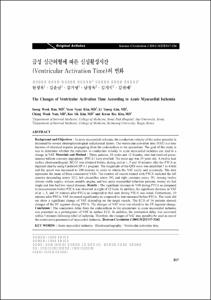KUMEL Repository
1. Journal Papers (연구논문)
1. School of Medicine (의과대학)
Dept. of Internal Medicine (내과학)
급성 심근허혈에 따른 심실활성시간 (Ventricular Activation Time)의 변화
- Keimyung Author(s)
- Han, Seong Wook; Kim, Yoon Nyun; Nam, Chang Wook; Kim, Kee Sik; Kim, Kwon Bae
- Department
- Dept. of Internal Medicine (내과학)
- Journal Title
- 순환기
- Issued Date
- 2001
- Volume
- 31
- Issue
- 3
- Abstract
- In acute myocardial ischemia,
the conduction velocity of the action potential is decreased by several electrophysiological and physical factors. The ventricular activation time (VAT) is a time duration of electrical impulse propagating from the endocardium to the epicardium. The goal of this study is was to determine whether the reduction in conduction velocity in acute myocardial ischemia can lead to a change in VAT. Materials and Method:Thirty patients, 18 males and 12 females, who had received percutaneous balloon coronary angioplasty (PTCA) were enrolled. The mean age was 59 years old. A twelve lead surface electrocardiogram (ECG) was obtained before, during, and at 1, 5 and 10 minutes after the PTCA as digitized data by using Cardiolab EP 4.1 program. The magnitude of the QRS wave was amplified 3 to 4-fold and the speed was increased to 200 mm/sec in order to obtain the VAT easily and accurately. The data represents the mean of three consecutive VATs. The number of vessels treated with PTCA included the left anterior descending artery (12), left circumflex artery (9), and right coronary artery (9). Among twelve chronic stable angina, sixteen unstable angina, and two acute myocardial infarction patients, twenty six had single and four had two vessel diseases. Results:The significant increase in VAT during PTCA as compared to measurements before PTCA was observed in eight of 12 leads. In addition, the significant decrease in VAT of at 1, 5, and 10 minutes after PTCA as compared to that seen during PTCA was noted. Furthermore, 10 minutes after PTCA, VAT decreased significantly as compared to that measured before PTCA. The leads did not show a significant change of VAT depending on the target vessels. The ECG of 16 patients showed changes of the ST segment during PTCA. The changes of VAT were not related to the ST segment change. Conclusion:The conduction delay from the endocardium to the epicardium in acute myocardial ischemia was presented as a prolongation of VAT in surface ECG. In addition, the conduction delay was recovered within 5 minutes follwoing relief of ischemia. Therefore, the changes of VAT may possibly be used as one of the noninvasive parameters of myocardial ischemia. (Korean Circulation J 2001;31(3):317-326) KEY WORDS:Acute myocardial ischemia·Electrocardiography·Ventricular activation time.
- Alternative Title
- The Changes of Ventricular Activation Time According to Acute Myocardial Ischemia
- Publisher
- School of Medicine
- Citation
- 한성욱 et al. (2001). 급성 심근허혈에 따른 심실활성시간 (Ventricular Activation Time)의 변화. 순환기, 31(3), 317–326.
- Type
- Article
- ISSN
- 1225-164X
- Appears in Collections:
- 1. School of Medicine (의과대학) > Dept. of Internal Medicine (내과학)
- 파일 목록
-
-
Download
 oak-bbb-4659.pdf
기타 데이터 / 954.23 kB / Adobe PDF
oak-bbb-4659.pdf
기타 데이터 / 954.23 kB / Adobe PDF
-
Items in Repository are protected by copyright, with all rights reserved, unless otherwise indicated.